JKBOSE 10th Class Science Solutions Chapter 15 Our Environment
JKBOSE 10th Class Science Solutions Chapter 15 Our Environment
JKBOSE 10th Class Science Solutions Chapter 15 Our Environment
Jammu & Kashmir State Board JKBOSE 10th Class Science Solutions
J&K class 10th Science Our Environment Textbook Questions and Answers
BASIS AND BASICS
◆ A biotic community survives in an environment entirely by materials and energy provided by its environment.
◆ Environment is the sum total of all external conditions and influences that affect the life and development of an organism, i.e., the environment includes all the physical or abiotic and biological or biotic factors.
◆ Ecosystem is defined as interaction between physical environment and biotic community.
◆ Ecosystem is a unit of the environment that can be identified and studied.
◆ Term ‘Ecosystem’ was coined by Sir Arthur Tansley (1935).
◆ The various components of ecosystem are interdependent.
◆ Ecosystem can be natural or artificial, small or large and temporary or stable.
◆ An ecosystem has a defined organization having two structural components i.e. biotic and abiotic.
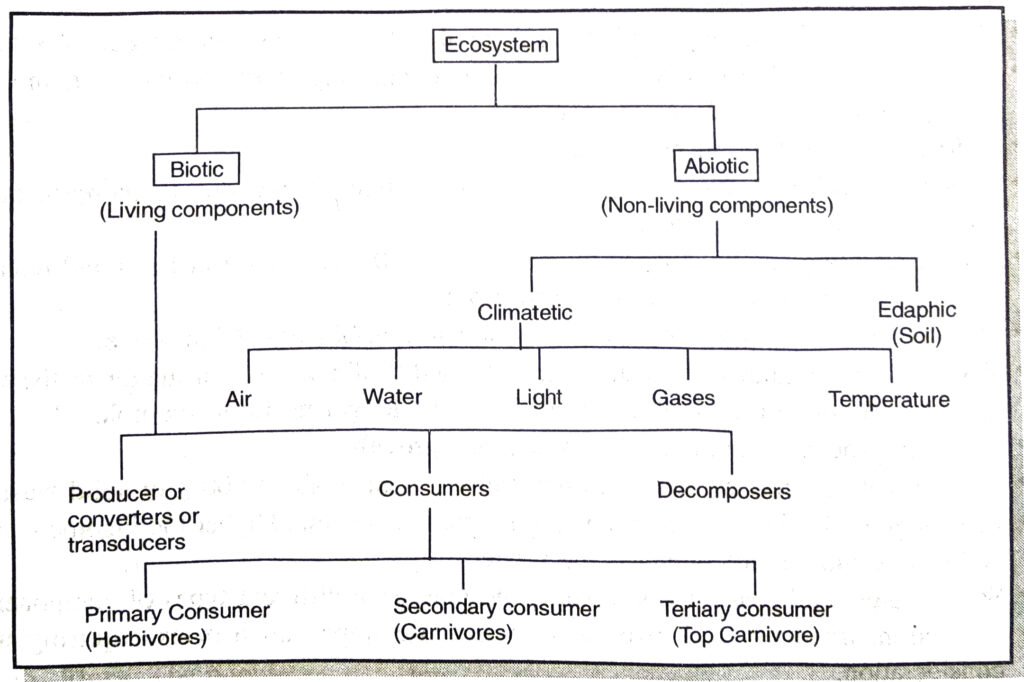
◆ Ecosystem may vary in size such as small pond or a large forest or ocean.
◆ Two major categories of ecosystems are terrestrial and aquatic ecosystems.
◆ Its functional components include the volume and rate at which materials circulate and energy flow as well as the process of interaction between biotic and abiotic components.
◆ The biotic components of any natural ecosystem comprise (i) producers (ii) consumers (primary and secondary) and (iii) decomposers.
◆ Both materials and energy enter living world through the producers.
◆ Ecosystem can be physically delineated.
◆ The simplest food relation in an ecosystem is food chain.
◆ Food Chain. The transfer of energy from one trophic level to next trophic level is called food chain.
◆ Each step in the food chain constitutes a trophic level.
◆ Food Web. Interconnected matrix of food chains is called food web.
◆ The producers make the energy from sunlight available to the rest of the ecosystem.
◆ There is a loss of energy as we go from one trophic level to the next, this limits the number of trophic levels in a food chain.
◆ Human activities have an impact on the environment.
◆ Chlorofluorocarbons, chlorine, nitrogen oxide, carbon tetrachloride, halon and methyl chloroforms have ozone depleting potential.
◆ Thinning in ozone layer allows harmful U.V. rays to reach earth surface.
◆ Skin cancer, cataracts and weakened immune system are some of the harmful affects of U.V. radiations.
◆ U.V. rays affects photosynthesis in plants.
◆ Ozone is deadly poisonous.
◆ Ozone layer in higher layers of atmosphere absorbs UV rays emerging from sun.
◆ Ozone depletion has resulted in UV radiations reaching earth and causes skin cancer, damage to eyes and defence mechanism.
◆ Acid rain is result of air pollution.
◆ Global warming is due to slow rise in earth’s temperature due to increase of CO₂ concentration in the atmosphere.
◆ Global warming can be stopped by cutting down the use of fossil fuels and release of green house gases such of chlorofluorocarbon.
◆ Wastes are of two types i.e. biodegradable and non-biodegradable waste.
◆ WHO (World Health Organisation) has defined “solid waste is a matter in the wrong place i.e., a non-liquid, no-gaseous substance no longer useful to the holder.”
◆ It is a by-product of human development and growth.
◆ Approximately every resident of urban India generates about 500 g of solid waste.
◆ Its generation is directly proportional to sources of income. Higher the income-greater is the consumption and bigger is the waste.
◆ Solid waste is a heterogenous mixture and may have different types of components.
◆ Collection, treatment and disposal of waste are important aspects requiring urgent consideration.
Modes of disposal of wastes are:
◆ Landfills. It is the the method used in urban areas to bury the solid waste in low-lying areas to level the uneven ground.
◆ Recycling. It is the method of recovery and processing of biodegradabe wastes or materials after they have been used, which enables them to be reused.
◆ Composting. In this method, the domestic waste like fruit and vegetable waste, left-over food, leaves of potted plants, etc., can be converted into compost and used as manure.
◆ Incineration. It means ‘reduction to ashes’. The burning of a substance at high temperature to form ash is called incineration. It is used to destroy household waste, chemical waste and biological waste. Incineration is carried out in an incinerator.
IMPORTANT TERMS AND FACTS TO MEMORISE
⇒ Ecosystem. The interchange of energy and matter between biotic and abiotic to components is called as ecosystem.
⇒ Biome. When eco-systems combine, a larger system is formed which is called as Biome.
⇒ Biosphere. When all the biomes of world combine together resulting into a large unit that is termed as biosphere. It is considered to be the largest biological system.
⇒ Hydrosphere. The part of Earth covered with water is called hydrosphere.
⇒ Lithosphere. The outer crust of our planet Earth is called lithosphere.
⇒ Atmosphere. The multi layered gaseous envelope of air that covers the whole of our planet Earth like a blanket is termed as atmosphere.
⇒ Consumer. Those organisms which cannot produce their own food and consume vited already formed food are called consumers.
⇒ Nutrition. Nutrition is the process of providing or receiving nourshing substances with the help of food chain.
⇒ Food chain. A chain formed by producers, consumers hey and decomposers is called food chain. It is a series of organisms feeding on one another at various biotic levels.
⇒ Food web. The network of overlapping food chains is called food web.
⇒ Biogeochemical cycle. A constant interaction between the biotic and abiotic components of the biosphere makes it dynamic but stable system. These interactions consist of a transfer of matter and energy between the different components of the biosphere.
⇒ Macronutrients. The nutrients which are required in large amount by the body are toy called macronutrients. e.g. H, N, C, O, P.
⇒ Micronutrients. The nutrients which are required in small amount by the body are called micronutrients. e.g. Mn, Zn, Cu, etc.
⇒ Water cycle. The whole process in which water evaporates and falls on the land as rain and later flows back into the sea via rivers is known as water cycle.
⇒ Primary Consumers. Those organisms which eat plants or their products are known as herbivores or primary consumers.
⇒ Secondary consumers. Those organisms which eat flesh of other animals are known as carnivores or secondary consumers.
⇒ Flora. The population of plants and trees in a region.
⇒ Fauna. The animal population of a region.
⇒ Community. Group of plants and animals living together e.g. plants and animals living in a pond.
TEXT BOOK QUESTIONS (SOLVED)
Q. 1. Why are some substances biodegradable and some non-biodegradable ?
Ans. Some substances such as paper, clothes, vegetables, wood etc. can be broken down into simple substances by the action of living organisms are said to be biodegradable.
There are e other substances such as meta such as metals, plastics etc. which cannot be broken down are termed non-biodegradable substances.
Q. 2. Give any two ways in which biodegradable substances would affect the environment.
Ans. 1. Biodegradable substances get simplified by the action of micro-organisms and the simple components are restored to environment.
2. They help in recycling i.e. Gobar gas plant is best example of recycling in which dung and faeces are utilized to produce gas for cooking and the remains form important manures.
Q. 3. Give any two ways in which non-biodegradable substances would affect the environment.
Ans. 1. The non-biodegradable substances add to the pollution.
2. Biomagnification of pesticides such as D.D.T. in the body of living system is very harmful.
3. Solid waste leads to generation of methane which is causing global warming.
Q. 4. What is trophic level? Give an example of food chain and state the different trophic levels in it.
Or
Draw a graphic sketch of food chain.
Ans. Trophic levels. The various steps in a food chain where transfer of food (energy) takes place are called trophic levels. Producer formed by green plants form first trophic level in a food chain.
Food chain. It is a sequential list of one organism It is consuming the other.
A simplest form of food chain is represented as Producer → Herbivore → Carnivore
Characters of food chain.
1. It is always straight.
2. In shorter food chain, the greater is the available energy.
3. The number of steps in any food chain is restricted to four or five.
4. There is always unidirectional flow of energy in a food chain.
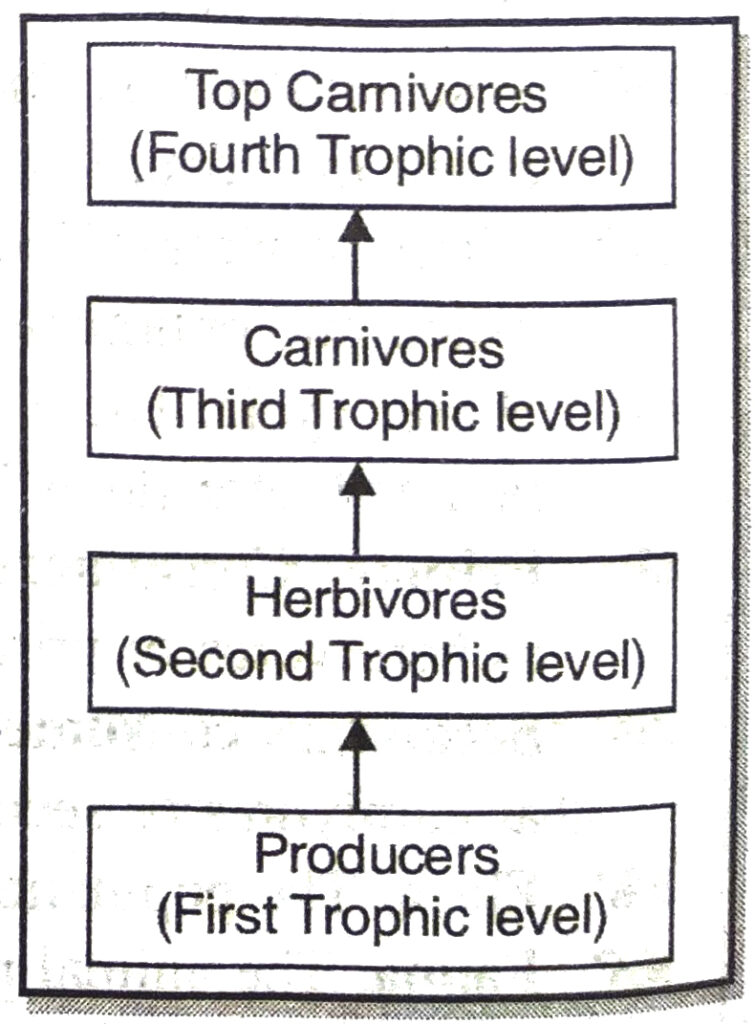
Q. 5. What is the role of decomposers in the ecosystem?
Ans. Decomposers feed on the dead bodies of plants and animals. They return the simple components to soil and help in making the steady state of ecosystem. Decomposers are essential component of an ecosystem. They create a balance in the environment. They are called natural changing agents.
Q. 6. What is ozone and how does it affect any ecosystem ?
Ans. Ozone. Ozone is a molecule formed by three atoms of oxygen in the presence of UV rays.  The oxygen is essential for all aerobic forms of life but ozone is a deadly poison.
The oxygen is essential for all aerobic forms of life but ozone is a deadly poison.
Ozone performs important function at the higher level of atmosphere. Ozone absorbs UV rays from the sun. Thus protect the living system on earth.
Q. 7. How can you help in reducing the problem of waste disposal, give any two methods ?
Or
Give any two ways to manage garbage at home.
Ans. 1. Recycling of wastes
2. Reduction at source
3. Better management
4. Biogas plants can be installed for using waste of kitchen and other organic matter as biomass.
5. Use of ecofriendly products such as disposable paper cups in place of plastic cups.
TEXT BOOK EXERCISES (SOLVED)
Q. 1. Which of the following groups contains only biodegradable items:
(A) Grass, flowers and leather
(B) Grass, wood and plastic
(C) Fruit-peels, cake and lime-juice
(D) Cake, wood and grass.
Ans. (A), (C) and and (D) groups.
Q. 2. Which of the following constitute a food chain ?
(A) Grass, wheat and mango
(B) Grass, goat and human
(C) Goat, cow and elephant
(D) Grass, fish and goat,
Ans. (B) Grass, goat and human.
Q. 3. Which of the following are environment-friendly practices ?
(A) Carrying cloth-bags to put purchases in while shopping
(B) Switching off unnecessary lights and fans
(C) Walking to school instead of getting your mother to drop you on her scooter
(D) All of the above.
Ans. (D) All of above.
Q. 4. What will happen if we kill all the organisms in one trophic level?
Ans. 1. If we kill all the organisms in one trophic level, imbalances are created in the food chain.
2. The population of organisms in pervious trophic level will increase. If we kill population of frogs in the following food chain, the population of insects will increase to a great level and in turn they will damage the green plants.
Green plants → Insects → Frog
3. The population of organisms in the next trophic level will decrease.
4. Ecological balance will be disturbed.
Q. 5. Will the impact of removing all the organisms in a trophic level be different for different trophic levels ? Can the organisms of any trophic level be removed without causing any damage to the ecosystem ?
Ans. Removing all the organisms of a trophic level will affect different trophic levels in different ways..
(i) Effect of removing producers. Eco-system will be completely destroyed if we kill all the producers, there will be no life.
(ii) Effect of removing herbivores. Population of producers (plants and trees) will increase enormously if we kill all the herbivores and carnivores will die because of hunger.
(iii) Effect of removing carnivores. If we kill all the carnivores, then the population of herbivores will increase and it will destroy all the vegetation of a region.
(iv) Effect of removing decomposers. Killing all decomposers will lead to the heaps of dead bodies all around. Various microbes will increase and they will cause different types of diseases. It will lead to deficiency of elements necessary for the growth of plants.
Removal of organisms in a trophic level without affecting the ecosystem is not possible. If we destroy producers, herbivores cannot survive and if we kill herbivores, then carnivores cannot live.
Q. 6. What is biological magnification ? Will the levels of this magnification be different at different levels of the ecosystem ?
Or
What is biological magnification ? What are its effects ?
Ans. Biological magnification. The phenomenon in which the harmful pollutants (such as pesticides) enter the food chain and get concentrated more and more at each successive trophic level of organisms is called biological magnification.
The level of bio magnification will be different at different trophic levels of the ecosystem. STUDENT S This can be illustrated by the ahead example :
Illustration :
A large number of toxic chemicals like pesticides, weedicides, insecticides and fungicides are used to protect the crop plants from pests and diseases. Some of these chemicals get mixed up with the soil whereas others get washed down into the surface water bodies like ponds, rivers, etc., and the underground water bodies.

Water in a pond, lake or river contain only a small amount (0.02 ppm) of the harmful chemicals. The algae (phytoplankton) and protozoa (zooplankton) which utilize this water, contain a higher proportion (5 ppm). The fish which feeds on these organisms has a still higher amount of 240 ppm. Birds which feed on these fish contain the highest amount (1600 ppm).
Level of concentration increases as we go higher in food chain.
Therefore, we observe that as we go higher and higher in the food chain, the concentration 18 of pesticides in the body of the organisms gradually increases. For example, in the above example, the biological magnification of harmful pesticides goes up to 8000 times from water to fish eating birds.
Effects of biological magnification.
This is the reason why our food grains such as wheat and rice, vegetable and fruits and even meat contain varying amounts of pesticides residues. So, the highest trophic level at the extreme right of food chain has the maximum concentration of harmful chemicals in a food-chain.
Q. 7. What are the problems caused by the non-biodegradable wastes that we generate?
Or
Explain two ways in which non-biodegradable substances affect our environment.
Ans. Problems caused by non-biodegradable wastes
1. Non-biodegradable solid waste is great environmental hazard.
2. Plastic and their waste products such as carry bags, waste glasses, bottles, cups, plates are most dangerous. They choke in drain..
3. They cause soil pollution and degrade the soil.
4. They prevent growth of vegetation when dumped underground.
5. Water pollution will make this water not fit for drinking.
6. The plastic wastes when mixed with municipal waste make them unfit for recycling.
7. Non-biodegradable substances may be inert and simply persist in the environment for a long time and may harm various members of the ecosystem.
Q. 8. If all the wastes we generate is biodegradable, will this have no impact on the environment ?
Ans. If all the wastes are biodegradable they will help in maintaining the neat, clean, stable environment.
Q. 9. Why is damage to the ozone layer is a cause of concern? What steps are being taken to limit this damage ?
Ans. Ozone layer absorbs ultraviolet radiation of the sunlight which is very harmful to human beings. If the ozone layer in the atmosphere is depleted, these radiations would reach the earth and would cause many damages such as skin cancer, genetic disorders in man and other living beings.
The steps taken to limit the damage of ozone layer are as follows:
1. Judicious use of aerosol spray propellants such as fluorocarbon and chlorofluorocarbons which cause depletion or hole in ozone layer.
2. Limited use of supersonic planes.
3. Control over large scale nuclear explosions.
ADDITIONAL IMPORTANT QUESTIONS
LONG ANSWER TYPE QUESTIONS
Q. 1. Write the factors for excessive solid waste generation.
Ans. Factors for excessive solid waste generation :
1. Food habits
2. Changed life style
3. Use and throw policy
4. Excessive per capita resource need
5. Increasing population density
6. Richer the society, more the waste
7. Geographic location
8. Season of the year
9. Extent of recycling
10. Public attitude
11. Legislation.
Q. 2. Explain the organisation of an ecosystem.
Or
What are differences between biotic and abiotic components of an ecosystem ?
Ans. Organisation of the Ecosystem
The structural component of an ecosystem may be classified under two main types:
(i) Biotic components
(ii) Abiotic components
The biotic components comprise the kinds, number and distribution of living organisms present in an ecosystem. These include plants, animals and micro-organisms (bacteria and fungi). Abiotic components consist of the kinds, quantity and distribution of physical and chemical factors such as light, temperature, water, oxygen, carbon, nitrogen and minerals. In this way, it is concerned with energy and materials.
The functional aspect of an ecosystem involves the volume and the rate at which the various materials circulate e and the rate at which the energy flows through it. The flow of energy is unidirectional. The sun is the ultimate source of energy.
Thus, the study of ecosystem involves the description of biotic communities and the abiotic environment alongwith an understanding of the whole network of relationship involving the exchanges and interactions in these components.
Biotic Components
The biotic components of an ecosystem has been classified by Odum (1971) into three groups:
(i) Producers (Green plants)
(ii) Macro consumers (Usually animals)
(iii) Micro consumers (organisms like bacteria and fungi.)
Abiotic components
Though all the abiotic factors are not yet known but many have been understood. Various important biotic factors have been classified as follows:
(i) Climatic factors. These include light, temperature, precipitation, atmospheric humidity and wind.
(ii) Topographic factors. These include altitude, surface slope and exposure etc.
(iii) Edaphic factors. These include soil and substratum.
Examples of food chains
(i) Grass →Goat →Man
(ii) Grass →Deer – →Lion
(iii) Algae →Zooplankton →Fish →Man
(iv) Seed→Rat →Cat →Dog →Hawk
(v) Algae →Insects →Frog →Snake →Peacock, etc.
Q. 3. What are the two main components of an ecosystem ? Describe the physical factors which affect the distribution of organisms in different habitats.
Ans. Abiotic (physical) and biotic components are the two main components of an ecosystem.
Abiotic components or Physical environment.
1. Temperature. The physiological and behavioural adaptations of most animals depend upon the changes in the environmental temperature. The rates of photosynthesis and respiration in plants also fluctuate depending upon the change in temperature.
2. Water. The extent to which an organism is dependent on an abundant water supply depends on its requirements and its ability to conserve it in adverse conditions. Organisms living in dry habitats generally have good water conservation such as in cacti, camels.
3. Light. This is essential for all green plants and photosynthetic bacteria and for all the animals dependent on the plants.
4. Humidity. This is important because it can affect the rate at which water evaporates from the surface of an organism, which in turn influences its ability to withstand drought.
5. Wind and air currents. This particularly applies to plants. Only plants with strong root systems and tough stems can live in exposed places where winds are fierce. Wind is also instrumental in the dispersal of spores and seeds.
6. pH. This influences the distribution of plants in soil and fresh-water ponds. Some plants thrive in acidic conditions others in neutral or alkaline conditions. Most are highly sensitive to changes in pH.
7. Soil nutrients. These particularly affect the distribution of plants in the soil.
8. Water currents. These particularly affect the organisms in rivers and streams. Only organisms capable of swimming or avoiding strong currents can survive.
9. Topography. Minor topographical differences may be just as important in influencing the distribution of organisms as wide geographical separation.
10. Background. The distribution of organisms whose shape or colouration are such that they are camouflaged when viewed against a particular background is related to the general texture and pattern of the environment.
Q. 4. Explain the concept of Food Chain.
Or
What is Food Chain ?
Ans. Food Chain. A food chain consists of a connected group of producers, consumers and decomposers. It starts with energy from the sun and nutrients from the soil. They pass through a plant and one or several consumers to final consumer that is not fed upon by other. Even then one may have parasites, and in time it will certainly die. The food relation in simplest from grass-deer-tiger-micro-
A common example of food chain is that involving the plants and grazing antelopes. The plants are producers and the antelope being herbivorous are primary consumers. The antelopes in turn are consumed as food by carnivorous animals, such as lion and cheetah. They constitute a group called secondary consumer. Whatever is left may be decomposed by bacteria and fungi thus return the simple components to soil. The last group constitute the decomposers. In the Fig. green plants are the producers, mouse is the primary consumer and kite is tertiary consumer. Thus a food chain is set-up.
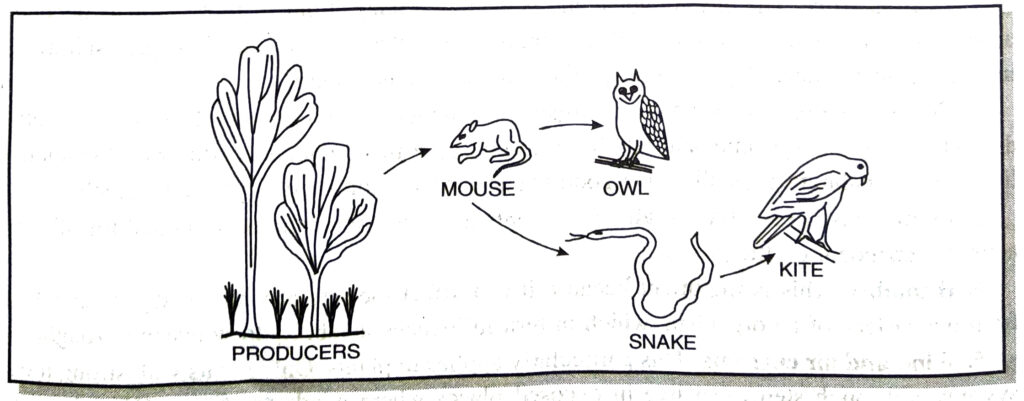
Q. 5. Depict diagramatically a food web in any ecosystem. How many food chains are there in that food web?
Ans. Food web. When various food chains sequences are inter-connected with one another in an interlocking pattern, then it is known as food web.
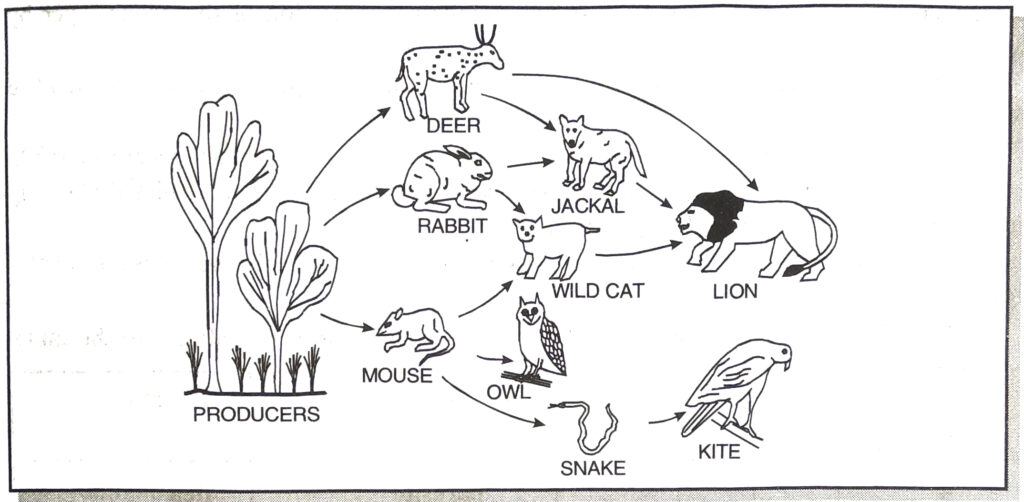
There are seven food chain in the food web depicted above.
Q. 6. Name the two fundamental trophic levels and describe the general makeup of each.
Ans. The two fundamental trophic levels include the following:
1. Producers (Autotrophic organism). The green plants are the producers in any ecosystem. They also include photosynthetic bacteria. The producers use radiant energy of the sun during photosynthesis whereby carbon dioxide is assimilated and the light energy is converted into chemical energy. This energy is locked up into the energy rich carbon compounds i.e. carbohydrates. The oxygen that is evolved as a by-product in photosynthesis is used in respiration by all living organisms.
2. Consumers (Heterotrophic organisms). They are the living members of the ecosystem which consume the food synthesized by the producers. All living animals are thought to be consumers. The consumers may be of the following types :
(i) Primary consumers (also called first order consumers) which are purely herbivorous and depend upon green plants i.e. on producers for their food e.g., Cow, Goat, Rabbit, Deer, Grasshopper and other insects.
(ii) Secondary consumers (also called second order consumers) which are carnivorous and eat flesh of herbivorous animals e.g., Tiger, Lion, Dog, Cat, Frog, etc.
(iii) Tertiary consumers are the carnivorous animals that eat other carnivores e.g. Snake eats a frog, bird eat fishes.
(iv) Top consumers are carnivores of an ecosystem which are not killed and eaten by other animals e.g. Lions, vultures etc.
Q. 7. Discuss causes of depletion of ozone layer.
Ans. Causes of depletion of ozone layer:
1. CFCs (chlorofluorocarbons) are responsible for depletion of ozone layer. When the harmful chemicals like chlorofluorocarbons (CFCs) are released into the air it accumulates in the upper atmosphere and reacts with ozone resulting in reduction of the ozone layer by forming a hole.
2. Free radicals can also cause depletion of ozone layer. Supersonics can also deplete ozone layer.
3. The other factor responsible for ozone destruction is the pollutant nitrogen monoxide (NO).
4. Thus, the ozone layer in the atmosphere becomes thinner and gets depleted allowing more ultraviolet rays to pass through the earth.
5. The Antarctic hole in ozone layer is caused due to chlorine molecules present in chlorofluorocarbons (CFCs), that are used by human beings.
Q. 8. This pyramid of numbers has four trophic levels. Fill in the blanks in the table.

Ans.
1. Producer
2. Grasshopper
3. Secondary consumer.
SHORT ANSWER TYPE QUESTIONS
Q. 1. What is solid waste ? Classify it on the basis of nature of waste.
Ans. Solid wastes. The wastes arising from human activities are called solid wastes. It can be explained as a “Resource out of place.” Classification of solid wastes on the basis of nature.

Q. 2. Differentiate biodegradable and non-biodegradable pollutants. Classify the following under the above two categories : DDT, Paper, Cotton cloth, Plastics.
Ans.
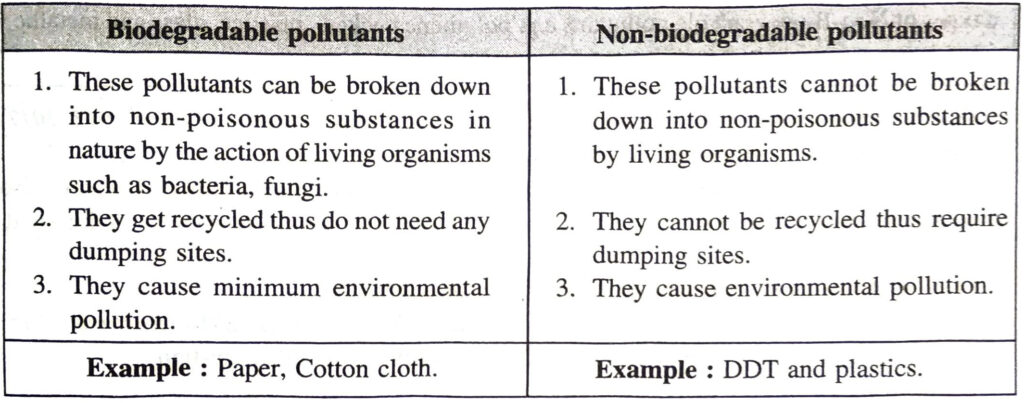
Q. 3. What happens when we add waste to the environment ? Explain.
Ans. Problems caused by the wastes
1. Solid waste is great environmental hazard.
2. Plastic and their waste products such as carry bags, waste glasses, bottles, cups, plates are most dangerous. They choke in drain.
3. They cause soil pollution and degrade the soil.
4. They prevent growth of vegetation when dumped underground.
5. Water pollution will make this water not fit for drinking.
6. The plastic waste when mixed with municipal waste make them unfit for recycling.
7. Non-biodegradable substances may be inert and simply persist in the environment for a long time and may harm various members of the ecosystem.
Q. 4. List the abiotic components of an ecosystem.
Ans. The abiotic components of an ecosystem are of two types: (i) Climate including temperature, light, wind, gases, humidity, rain and water (also wave action, water currents); and (ii) edaphic including soil, substratum, background, minerals and pH.
Q. 5. List the biotic and abiotic components of ecosystem.
Ans. Differences between Biotic and Abiotic components of ecosystem Biotic Components
1. Biotic components of an ecosystem are those living substances which are different members of a community.
2. Biotic components of an ecosystem are :
(i) Producers
(ii) Consumers
(iii) Decomposers.
Abiotic Components
1. Abiotic components are non-living factors.
2. It includes water, minerals, salts, humidity, light, temperature, pH, wind, topography and background. In
Q. 6. Explain functions of ecosystem.
Ans. Functions of ecosystem
1. Energy flow. The energy flow from producers to consumers. There is loss of energy at every trophic level.
2. Biogeochemical cycle. The cyclic flow of nutrients between non-living environment and living organisms is called biogeochemical cycles.
Q. 7. List the key functional aspects of ecosystems.
Ans. 1. Productivity and energy flow.
2. Nutrient cycling.
3. Development and stabilization.
Q. 8. What is food chain ? List the kinds of food chains.
And. Food Chain. A nutritive interaction among biotic communities (Organisms) involving a producer, various levels of consumers and a decomposer forms a food chain. Each step in a food chain is called a trophic level.
Kinds of food chain. There are three kinds of food chains predator, parasitic and saprophytic chains.
Q. 9. Differentiate first trophic level and third trophic level.
Ans. Differences between first trophic level and third trophic level
| First trophic level | Third trophic level |
| (i) These are producers and transform solar energy into chemical energy by photosynthesis. | (i) These are consumers and depend upon other animals for their food. |
| (ii) Consists of green plants, e.g. grass. | (ii) Consists of carnivores e.g., lion. |
Q. 10. Differentiate second trophic level and fourth trophic level.
Ans. Differences between second trophic level and fourth trophic level.
| Second Tropic Level | Fourth Trophic Level |
| They are herbivores and they depend on only plants for their food. They belong to first order consumers, e.g., deer and grasshopper. | They are carnivores and depend upon other animals for their food. They belong to third order consumers, e.g., snake and peacock. |
Q. 11. What will happen if all the decomposers are removed from the ecosystem ?
Ans. If the decomposers are removed from the ecosystem :
(i) Complex organic matter will not be broken. So nutrients will not return to nutrient pool.
(ii) Nutrients cycles will be disturbed.
(iii) Balance in the eco-system will be disturbed.
(iv) Waste materials will get accumulated.
Q. 12. What is the meaning of the effect of energy in an ecosystem ? Explain with example how energy is lost at the various energy levels.
Ans. In the ecosystem there is continuous and unidirectional flow of energy. The energy from the sun through the various energy levels finally reaches the tertiary consumers. These various energy levels are joined by a food chain. Many food chains overlap and form a food web.
Loss of energy at different levels
Trapped energy is fixed in form of complex organic compounds and is used by herbivorous and carnivorous animals. But the energy does not terminate or end here. When the organism dies, then the dead body gets mixed with the soil. Indirectly it can be said that the complex energy rich compounds from the dead body are now utilized by decomposers or scavangers, and then ultimately energy is released back into nature after decomposition. Thus we see, at every level, organisms make use of energy and as a result of use of energy when life activity occurs then energy is lost and therefore supply of energy is continuously required from the sun.
Q. 13. Why are bacteria and fungi called decomposers ? List any two advantages of decomposers to the environment?
Ans. Decomposers. Fungi and bacteria feed on dead plants and animals. They break down the complex organic matter to simple components.
Advantages of decomposers.
1. They return the simple components to the soil.
2. They help in maintaining steady state of environment.
Q. 14. Give an account of factors affecting the rate of decomposition.
Ans. Factors affecting decomposition :
1. Upper layer of soil is the main site of decomposition processes in the ecosystem.
2. The rate of decomposition of detritus is affected by climatic factors and chemical quality of detritus.
3. Temperature and soil moisture affect the activities of root microbes.
4. The chemical quality of detritus is determined by relative proportion of water soluble substances, polyphenols, lignin and nitrogen.
Q. 15. What is primary production ? How are we dependent on it ?
Ans. Chlorophyll bearing plants act as producers. They convert the solar energy into chemical form of energy by the process of photosynthesis. Food thus formed is used by several organisms including man. Herbivores directly depend upon primary producers (green plants) for food supply.
Q. 16. What is biomass? How is the energy related to it ?
Ans. Biomass is living matter in any organism.
Truly speaking, biomass represents the quantity of living tissue as energy available in the form of food for organisms of next trophic level.
Q. 17. Discuss the transfer of energy from sun to carnivores.
Ans. Flow of Energy. The solar energy is trapped by plants (producers) in the form of carbohydrates. It flows in the food chain from herbivores to carnivores and at each level is utilized as mechanical energy. It is also lost as heat into atmosphere. Almost 90% of energy is used up at each trophic level and only 10% is transferred to next level.
Q. 18. With a simple sketch show flow of energy in an ecosystem.
Ans. Flow of energy in an ecosystem
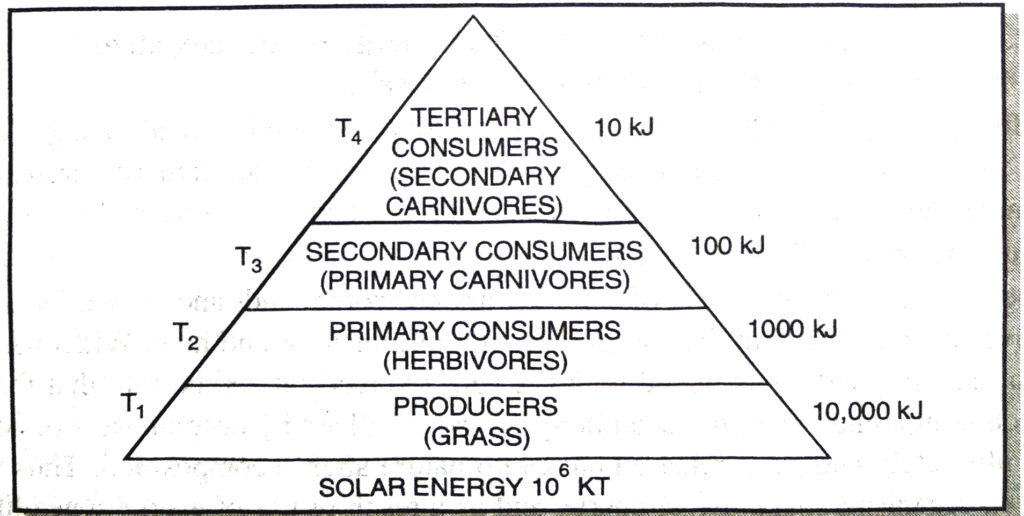
Q. 19. State any two advantages of studying food chain.
Ans. (i) It gives the direct relation of one type of food component from other.
(ii) The food chain helps us to know which position in food chain would help us to get more energy from the food we consume.
Q. 20. Write four characteristics of food web.
Or
What is food web?
Ans. Characteristics of Food Web
1. Unlike food chains, food webs are never straight.jun
2. Food web is formed by inter-linking of food chains.
3. Food web helps in ecosystem development.
4. Food web provides alternative pathways of food availability. Example, if a particular species of producers is destroyed by a disease in the ecosystem the herbivores of that area can feed on other species of producers.
Q. 21. Make a simple sketch to illustrate food web.
Ans. Food web
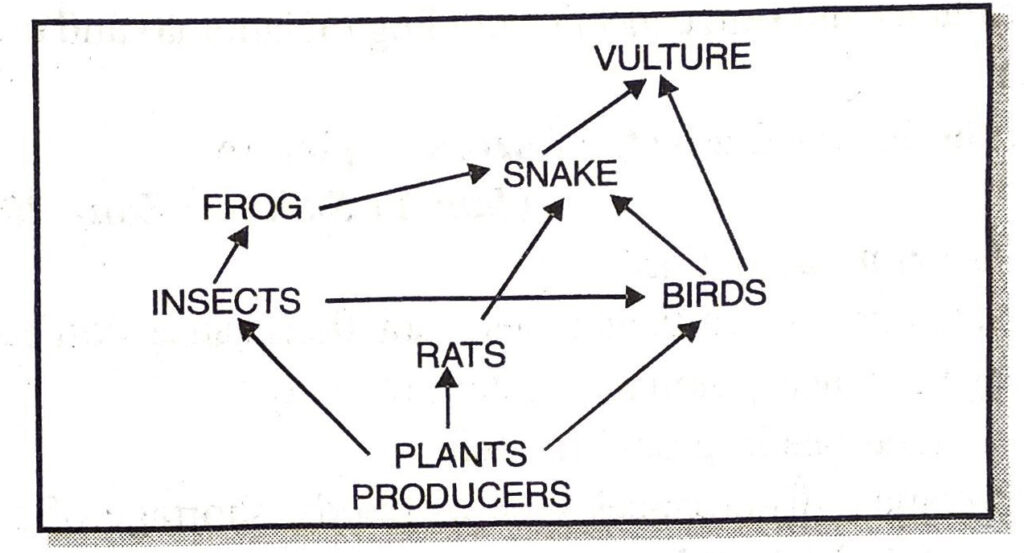
Q. 22. Differentiate between food chain and food web.
Ans. The main differences are :
| food chain | Food Web |
| 1. Food chain is the sequential list of om one organism consuming the other. | 1. Food web is the interconnected network of food chains operating in an ecosystem. |
| 2. Trophic level of each organism in a food chain is fixed. Therefore, each organism in a trophic level gets food from one group of organisms. | 2. Several food chains are interconnected in a food web. Therefore, each organism in a trophic level gets food from more than one group of organisms. |
Q. 23. What is ozone layer ?
Ans. Ozone layer. It acts as a blanket. Ozone is a molecule formed by three atoms of oxygen in the presence of UV rays.
Ozone performs important function at the higher level of atmosphere. Ozone absorbs UV rays from the sun. Thus protect the living system on earth.
Q. 24. What is ozone hole? What is its significance ?
Ans. Ozone hole. It means a complete disappearance of ozone layer over a part of atmosphere. During the period 1956-1970 the spring time O3 layer thickness above Antarctica varied from 280-325 Dobson unit. Thickness was sharply reduced to 225 DU in 1979 and 136 DU in 1985. The decline in spring time, ozone layer thickness is called ozone hole. It was first noted in 1985 over Antarctica.
Cooling of the stratosphere (where ozonosphere is located) will produce bigger ozone hole not only over Antarctica but also over Arctic region. Ozone layer will further thin out from rest of the stratosphere. It will be accompanied by major climatic changes all over the globe. Forests will be wiped out from many places. Radio communications will be disrupted.
Q. 25. What is the environment significance of the increasing Antarctica ozone hole ?
Ans. Effects of UV radiations on human. In humans, the increased UV radiation increases the incidence of cataract and skin cancer (including melanoma) and diminishes the functioning of immune system.
Q. 26. Write the harmful effects of ozone depletion.
Ans. Effects of ozone depletion.
1. UV radiation striking the earth and these radiations cause skin cancer and damage to eye.
2. These damage defence (immune) system of body.
3. May lead to variations in global rainfall.
4. It causes ecological disturbances such as floods, shortage of food etc.
Q. 27. Explain global Warming.
Ans. Global Warming or greenhouse effect. Carbon dioxide content of the air is increasing due to deforestation and combustion in industries, automobiles and planes, and is likely to become double by 2020. This increase is affecting the atmospheric composition and balance gases, which are among the factors that control earth’s climate. Increase of carbon dioxide may cause rise in atmospheric temperature, producing what is called the greenhouse effect. A rise of global temperature by more than 2 or 3 degrees may melt glaciers and polar ice. This will cause rise în ocean level and consequent flooding of coastal towns and submission of islands. Rainfall pattern may also change, affecting agricultural output.
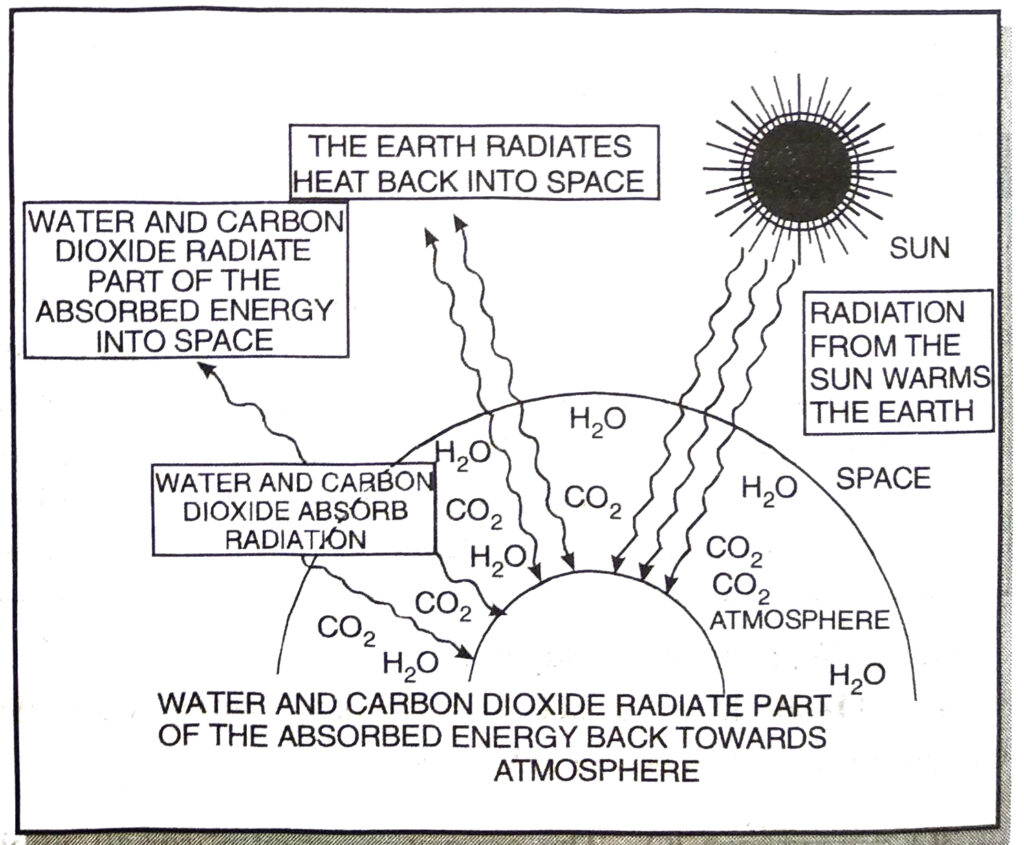
Q. 28. List four common methods of disposal of wastes.
Ans. 1. Incineration — Reduction to ashes.
2. Recycling — Recovery and processing to be used again.
3. Composting — Converting into compost to be used as manure.
4. Landfill — Bury the waste in low lying area.
Q. 29. What are the factors that have effected the soil fertility and degraded it ?
Ans. 1. Disposal of solid waste.
2. Use of chemical fertilizers and pesticides.
3. Soil erosion.
4. Deforestation.
VERY SHORT ANSWER TYPE QUESTIONS
Q. 1. Define solid waste as per WHO.
Ans. Solid waste is a matter in the wrong place.
Q. 2. What are biodegradable substances ? Name any two.
Ans. Biodegradable substances. The substances which can be broken down into simple substances by the action of living organisms (microbes – bacteria and fungi)
Examples. Wood, paper, clothes etc.
Q. 3. Name two non-biodegradable wastes.
Ans. Plastic, Metals.
Q. 4. Which term is used for pollutants that are degraded by natural means ?
Ans. Biodegradable.
Q. 5. Is D.D.T. biodegradable.
Ans. No.
Q. 6. Who coined the term ecosystem?
Ans. Sir Arthur Tansley (1869).
Q. 7. Define ecosystem.
Ans. Ecosystem. All the interacting organisms in an area together with the non-living constitute of environment.
Q. 8. What are two main components of ecosystem ?
Ans. Al Abiotic and Biotic ecosystem.
Q. 9. Where are the abiotic components present ?
Ans. Soil, water and air.
Q. 10. Give examples of ecosystem.
Ans. Garden, Forest, Ponds, Lakes.
Q. 11. Give one example of smallest and another of large sized ecosystem.
Ans. (i) Pond (ii) Forest
Q. 12. Name two major kinds of ecosystems.
Ans. 1. Terrestrial ecosystem.
2. Aquatic ecosystem.
Q. 13. Write three examples of terrestrial ecosystems.
Ans. Forests, grasslands and desert ecosystem.
Q. 14. Give three examples of fresh water ecosystem.
Ans. Ponds, lakes and streams ecosystem.
Q. 15. Name two salt water ecosystem.
Ans. Marine and estuaries ecosystem.
Q. 16. Name two man-made ecosystems.
Ans. 1. Crop fields 2. Garden.
Q. 17. Write two examples where man has interfered in ecosystem.
Ans. 1. Cutting of forests
2. Construction of dams.
Q. 18. How do decomposers obtain food ?
Ans. Decomposers release their enzymes into dead and decaying plants and animal remains and absorb the simple inorganic substances.
Q. 19. Construct the food chain comprising the following:
Snakes, Hawks, Rats, Plants.
Ans. The food chain is : Plants → Rats → Snakes → Hawks.
Q. 20. What is the source of energy used during photosynthesis ?
Ans. Sunlight.
Q. 21. What category of organisms form starting point of a food chain ?
Ans. Producers (plants) form the starting point of a food chain.
Q. 22. Green plants capture how much of total solar energy.
Ans.1 percent.
Q. 23. How much energy is passed from one trophic level to the next trophic level.
Ans. 10%.
Q. 24. What are phytoplanktons ? Give one example.
Ans. Phytoplanktons are microscopic aquatic plants which float on the surface of water in a pond, lake, river, etc. For example: Algae.
Q. 25. Why plants are called as producers ?
Ans. Plants are called producers because they produce the food by the process of photosynthesis.
Q. 26. Name two gases, other than carbon-dioxide, that are given out during burning of fossil fuel and contribute towards acid rain formation.
Ans. (i) SO2 and (ii) NO2.
Q. 27. Write formula of ozone gas. Where is it present ?
Ans. Formula of ozone = O3. It is available in the upper layers of atmosphere i.e. above 16 km from surface of earth. It is protective however it is highly poisonous if present at lower level.
Q. 28. Expand CFCs.
Ans. CFCs—Chlorofluorocarbons.
Q. 29. What percentage of solar energy falling on green leaves is trapped ?
Ans. 1%.
Q. 30. Name the ozone depleting substances.
Ans. Chloroflurocarbons CO2.
MULTIPLE CHOICE QUESTIONS
Select the correct answer out of the four alternatives :
1. Importance of ecosystem lies in :
(A) Flow of energy
(B) Cycling of materials
(C) Both (A) and (B)
(D) None of the above.
Ans. (C) Both (A) and (B)
2. An aquatic ecosystem consists of:
(A) biotic factors
(B) biotic and abiotic factors
(C) consumers only
(D) producers only.
Ans. (B) biotic and abiotic factors
3. Which of the following are not environment tanto friendly?
(A) Plastic bags
(B) Plastic cups
(C) Plastic buckets and jugs
(D) All of above.
Ans. (D) All of above.
4. The primary consumers in a pond ecosystem is :
(A) phytoplankton
(B) zooplankton
(C) fishes
(D) bacteria.
Ans. (B) zooplankton
5. Biotic components include:
(A) producers only
(B) consumers only
(C) producers and consumers only
(D) producers, consumers and decomposers.
Ans. (D) producers, consumers and decomposers.
6. In a food chain, there is :
(A) Bi-directional flow of energy.
(B) Zig-zag flow of energy.
(C) Uni-directional flow of energy.
(D) Multi-directional flow of energy.
Ans. (C) Uni-directional flow of energy.
7. Green plants are:
(A) autotrophs
(B) heterotrophs
(C) parasites
(D) saprophytes.
Ans. (A) autotrophs
8. Which organism is a decomposer ?
(A) Vulture
(B) Fungus
(C) Fox
(D) Frog.
Ans. (B) Fungus
9. The term ecosystem was coined by :
(A) Miller
(B) Haldane
(C) Tansley
(D) Darwin.
Ans. (C) Tansley
10. Global warming is the result of increase percentage of …………….. in atmosphere :
(A) Carbon dioxide
(B) Carbon monoxide
(C) oxides of nitrogen
(D) Sulphur.
Ans. (A) Carbon dioxide
11. The term ecosystem was coined by :
(A) Haldane
(B) Odum
(C) Tansley
(D) Oparin.
Ans. (C) Tansley
12. In a garden ecosystem, which of the following are producers ?
(A) Snakes
(B) Insects
(C) Rabbits
(D) Grasses, flowering plant.
Ans. (D) Grasses, flowering plant.
13. Ozone blanket is present in which of the following layers of atmosphere :
(A) Mesosphere
(B) Troposphere
(C) Stratosphere
(D) Thermosphere.
Ans. (C) Stratosphere
14. Of the total amount of energy that passes form one trophic level to another in a food chain, about 10% is :
(A) Transpired
(B) Burnt in respiration
(C) Stored in body tissues
(D) Loss as heat.
Ans. (C) Stored in body tissues
15. Forests provide which of the following to local people?
(A) Fodder
(B) Herbs and medicines
(C) Fruits and nuts for food
(D) All of above.
Ans. (D) All of above.
16. The use of chemicals like CFC’s has endangered the :
(A) Ozone layer
(B) Environment
(C) Atmosphere
(D) Ecosystem.
Ans. (B) Environment
17. Average value for amount of organic matter that is present at each step or level of food chain is :
(A) 20%
(B) 10%
(C) 30%
(D) 40%.
Ans. (B) 10%
18. The famous Dal Lake of Kashmir is shrinking and deteriorating due to :
(A) Human greed
(B) Dumping of domestic garbage and sewage
(C) Illegal encroachment
(D) All of above
Ans. (D) All of above
19. The river Jhelum is losing its glory due to :
(A) encroachment
(B) siltation
(C) entry of sewage of valley into its water
(D) All of above.
Ans. (D) All of above.
Follow on Facebook page – Click Here
Google News join in – Click Here
Read More Asia News – Click Here
Read More Sports News – Click Here
Read More Crypto News – Click Here